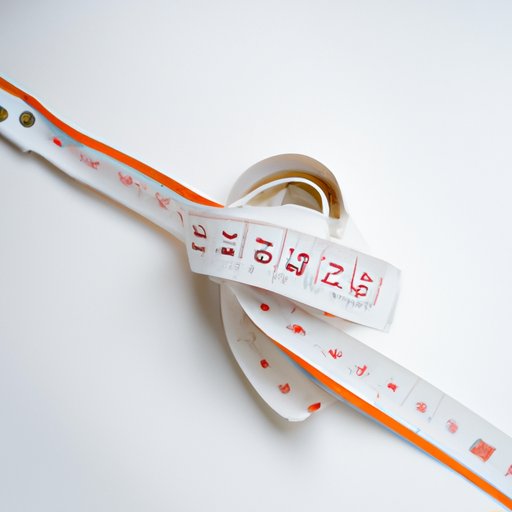Introduction
Measuring waist circumference is a key element of keeping track of your health and fitness. Waist measurements are more than just a basic physical attribute, but they can also tell a great deal about your health and overall well-being. This article will provide a comprehensive guide on how to measure your waist as accurately as possible, steps to take when measuring, common mistakes to avoid, and how to monitor and record progress over time.
Step-by-step guide to taking accurate waist measurements
When taking measurements, it is important to use the appropriate tool for accuracy. The ideal measuring tool is a flexible tape measure, such as a sewing tape or a tailor’s tape, that can be wrapped around your waist.
The next step is to stand upright, with your feet shoulder-width apart. Begin by locating your natural waist, which is the narrowest part of your torso, located just above your hip bone and below your ribcage. Next, wrap the measuring tape seamlessly around your waist, ensuring that it is level and not twisted. Take note of the reading on the tape measure, making sure not to hold your breath or suck in your stomach while doing so as it can affect the accuracy of your measurement.
One common mistake people make when measuring their waist is positioning the measuring tape too high or too low. This can lead to inaccurate readings, hence make sure to place the tape measure right above the hip bone but beneath the ribcage.
The importance of measuring waist circumference for health
Measuring waist circumference is pivotal for both health assessment and overall health status evaluation. Your ideal waistline size will depend on your age, height, gender, and other related factors. Research has shown that a larger waist circumference is associated with a higher risk of developing various health conditions that are unrelated to weight, such as metabolic disorders, insulin resistance, and heart disease. Therefore, measuring waist circumference can help you identify potential health risks early, leading to prompt interventions and lifestyle adjustments.
Best practices for measuring waist at home
If you want to measure your waist by yourself at home, there are several tips to consider. Firstly, make sure you remove any bulky clothing and wear tight-fitting clothes, and preferably avoid any items around your waist that could distort the measurement, such as belts or jewelry. Secondly, it’s best to measure your waist first thing in the morning on an empty stomach. Finally, when taking measurements, ensure that the tape measure is positioned around your natural waistline at an equal height at the front and the back.
There are devices and tools that can be used alongside a flexible tape measure, such as waist-to-hip ratio scales or waist-measuring apps. While technology can offer some help, the most accurate measurements are often obtained through manual measurements with a flexible tape measure to avoid errors in reading.
How to monitor waist size progress
When tracking your waist size progress, it’s essential to have a plan. Make sure you set realistic goals and check your measurements every few weeks to monitor your progress. Recording your measurements can also be helpful. This way, you can see how much weight you’ve lost or gained and adjust your diet and exercise plan accordingly. Keeping a journal can be helpful, so you have a clear record of your progress. If you’re having trouble staying motivated, consider finding a buddy or an accountability partner to keep you on track.
Problem areas to watch for when measuring waist
One common issue when measuring waist circumference is that the measuring tape may not be level, leading to inaccurate measurements. It’s also a common mistake to suck in your stomach or hold your breath while taking measurements, which can produce an incorrect reading.
Another issue to be aware of is bloating. If you experience bloating, it’s best to avoid measuring your waist during those times to get accurate results. Similarly, weight gain or weight loss will lead to fluctuations in your waistline measure as well, so be prepared to adjust your goals and plans accordingly.
Waist measurement and its connection to weight loss
Measuring your waist circumference and monitoring it consistently can be a beneficial tool in your weight-loss journey. Belly fat, particularly fat located around the midsection of your body, is associated with increased health risks such as heart disease, Type 2 diabetes, and high blood pressure. Reducing your waist circumference through effective lifestyle changes such as weight loss and healthy weight maintenance can decrease your risk of developing these conditions.
There are many diet and exercise programs that can help achieve a healthy waistline. Combining exercises such as cardio and strength training with a healthy eating plan is an effective way to trim your waistline. Also, focus on a balance of good nutrition, sleep, and maintaining low-stress levels to improve your waistline health.
Conclusion
In conclusion, measuring your waistline is a useful tool in assessing your overall health and evaluating potential health risks. It also offers an opportunity to monitor the effectiveness of lifestyle changes and can provide added motivation to make positive adjustments to your diet and exercise routines. With the step-by-step guide above and common mistakes to avoid, you can obtain accurate waist measurements and use this information to improve your overall health.
